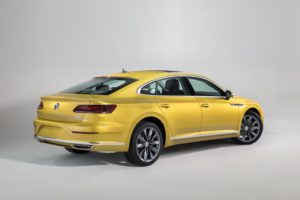
2019 VW Arteon 40% ultra-high-strength steel
By onMarket Trends | Repair Operations | Technology
Volkswagen on Thursday revealed the higher-strength steel-intensive 2019 Arteon, describing it as the OEM’s “flagship” and the successor to what had been known as the CC.
The new Arteon, which will hit dealerships in the fall, is built using Volkswagen’s Modular Transverse Matrix (“MQB”) platform. The architecture has for the 2018 Tiguan and Atlas SUVs meant extensive ultra-high-strength steel, and the same holds true for the luxury sedan.
“Arteon is 30 percent ultra high strength hot formed steel, 10 percent ultra high strength, and 36 percent extra high strength,” VW spokesman Mark Gillies wrote in an email Friday. “No aluminum as far as I can make out.”
Gillies last year provided a diagram of the European Tiguan body-in-white based off of the MQB platform and called the MQB Atlas a similar design as well. While the Arteon is clearly a different vehicle class than the two SUVs, the information might help give repairers anticipate where these grades of steel might occur on the car.
The diagram for the European Tiguan indicates that areas including the A- and B-pillars, transmission center tunnel, front floorwell (kickout panel), roof rails, inner frame rails, and rear floor crossmember are all “ultra-high-strength hot formed steel” with more than a gigapascal of tensile strength.
Regions including the Tiguan’s shotguns, another floor crossmember and roof crossmembers and other roof supports connected to the roof rails are also ultra-high-strength steel but below 1,000 megapascals. (Ultra-high-strength steel typically starts around 780 MPa.) The rest of the Tiguan body-in-white appears to be less than 420 MPa in tensile strength.
Delivering this combination of lightness and strength through ultra-high-strength steels comes with a tradeoff. For body shops, many if not all of these parts will be replace-only and carry very specific heat and sectioning restrictions.
Volkswagen noted that Arteon vehicle is longer and wider than the outgoing CC.
“The Arteon is based on Volkswagen’s Modular Transverse Matrix (MQB) architecture, which allows for a more cab-backward design, giving Arteon a completely different look than the outgoing CC,” Volkswagen wrote in a news release. “Arteon’s wheelbase is more than 5 inches longer than the CC—111.9 inches compared to 106.7 inches—and is paired with shorter overhangs for more dynamic proportions. Arteon is longer and wider as well, translating into more interior space.”
Volkswagen sold 1,355 CCs in 2017, 3,237 in 2016 and 6,276 in 2015. The car started at $34,475 for the 2017 model year.
“The Arteon is Volkswagen’s brand shaper,” Volkswagen North America CEO Hinrich J. Woebcken said in a statement. “This car is the spiritual successor to the CC, but it is bolder and faster. Arteon has the style and performance of a luxury Gran Turismo for about the price of a fully loaded midsize sedan.”
Besides its steel design, the 2019 Arteon should be notable for collision repairers because of its standard reactive hood, which launches itself into the air two inches to minimize the impact suffered by a pedestrian struck by the car.
“Sensors in the front of the car can detect if there is an impact with another vehicle or a pedestrian,” Volkswagen spokeswoman Jessica Anderson wrote in an email. “If the sensors detect a pedestrian collision, two small pyrotechnic charges connected to hinges at the rear of the hood fire. This raises the rear of the hood by about 2 inches, helping to mitigate pedestrian injuries by preventing impact with the engine below. The system is engaged between 15 and 35 mph.”
Other elements of interest to collision repairers:
- LED headlights and taillights are standard.
- The windows are frameless, and a sunroof is available as an option.
- A “power trunk with Easy Open and Close” is an option. The latter refers to the driver’s ability to wave a foot under the bottom of the vehicle and have the trunk automatically open.
- A backup camera is standard, as they are on all vehicles made after May 2018. Collision warning and autobraking also come standard.
- A lot of other ADAS systems are available as options, including lane-keeping and lane departure warnings, automatic high-beams, adaptive cruise control, autoparking and a 360-degree overhead camera system.
- Also available is what Volkswagen calls a “class-exclusive” post-collision braking option. The technology automatically stops the car after a crash is detected, keeping the collision from being intensified by the car’s subsequent motion.
More information:
“ALL-NEW 2019 VOLKSWAGEN ARTEON MAKES U.S. DEBUT AT THE CHICAGO AUTO SHOW”
Volkswagen, Feb. 8, 2018
Images:
The 2019 Volkswagen Arteon is based off of Volkswagen’s Modular Transverse Matrix (MQB) platform. (Provided by Volkswagen)
The 2018 Volkswagen Atlas is an example of a vehicle using the company’s Modular Transverse Matrix (MQB) architecture which will appear in the 2019 Volkswagen Arteon. (Provided by Volkswagen)
The 2019 Volkswagen Arteon, left, is based on the Modular Transverse Matrix (“MQB”), while its predecessor the 2017 CC isn’t. (Provided by Volkswagen)


